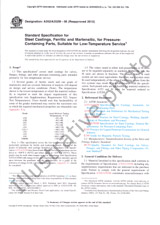We need your consent to use the individual data so that you can see information about your interests, among other things. Click "OK" to give your consent.
ASTM E2805-18
Standard Practice for Measurement of the Biological Activity of Ricin
Translate name
STANDARD published on 1.12.2018
The information about the standard:
Designation standards: ASTM E2805-18
Note: WITHDRAWN
Publication date standards: 1.12.2018
SKU: NS-909232
The number of pages: 13
Approximate weight : 39 g (0.09 lbs)
Country: American technical standard
Category: Technical standards ASTM
The category - similar standards:
Biology. Botany. ZoologyBiological evaluation of medical devices
Annotation of standard text ASTM E2805-18 :
Keywords:
biodefense, biological activity, cell culture, cell free translation (CFT) assay, enzymatic activity, forensic test, ricin, toxin,, ICS Number Code 07.080 (Biology. Botany. Zoology),11.100.20 (Biological evaluation of medical devices)
Additional information
| Significance and Use | ||||||
|
5.1 The CFT assay provides a sensitive and reliable method to detect ricin biological activity and results can be generated within 3 h. The assay measures the amount of ricin biological activity when compared to a known ricin standard and provides a quantitative measurement for active ricin. 5.2 The lower limit of quantitation and the upper limit of quantitation for ricin using the CFT assay were measured at 10 ng/mL and 170 ng/mL, respectively (5). 5.3 This practice is focused on the measurement of reference materials and not environmental samples. Additional control runs may be needed for measurements of environmental samples to ensure that the presence of additional materials in the samples (also referred to as the matrix) will not interfere with the measurements. 5.4 The CFT assay may be used to determine the presence of active ricin in forensic or bioterrorist samples if the appropriate controls are utilized to ensure valid results 5.5 The methods described in this document measure the biological activity of ricin and do not detect the presence of inactivated ricin in a given sample. 5.6 Ricin reference materials have a number of applications, such as testing detection devices, laboratory instruments, environmental sampling methods, disinfection studies, and basic research. |
||||||
| 1. Scope | ||||||
|
1.1 This guide is intended for the manufacturers and users of ricin reference material. Ricin reference materials are well-characterized materials that can be used to test detection devices and calibrate laboratory measurements. It is anticipated that ricin reference materials will be characterized by biochemical methods in addition to the measurement of biological activity. 1.2 This practice details the measurement of ricin biological activity using a cell-free translation (CFT) assay 1.3 The CFT assay has been developed for use in any biotechnology laboratory where determination or confirmation of ricin biological activity is required. 1.4 The CFT assay has been validated by the U.S. Army Medical Research Institute of Infectious Diseases (USAMRIID) VP-016 Validation of Cell-Free Translation Assay for the Detection of Ricin Toxin Biological Activities in compliance 1.5 Appendix X1 and Appendix X2 also provide guidance for the measurement of the biological activity of ricin using cell-based assays and the use of synthetic enzyme substrates. 1.6 Ricin is a category 2 select agent and acquisition of the ricin standard must adhere to the Center for Disease Control and Prevention (CDC) regulations. Ricin is listed on the select agent list (42 CFR Part 72).3 The possession, transfer, and use of ricin are restricted under the Public Health Security Preparedness Act (CRS Report RL31263 Public Health Security and Bioterrorism Preparedness and Response Act (P.L. 107-188): Provision and Changes to Preexisting law). Access to stores of ricin is limited (USA Patriot Act, P.L. 107-56). Ricin is also a prohibited substance under the Biological Weapons Convention and the Chemical Weapons Convention (CRS Report RL31559 Proliferation Control Regimes: Background and Status). 1.7 The values stated in SI units are to be regarded as standard. No other units of measurement are included in this standard. 1.8 This standard does not purport to address all of the safety concerns, if any, associated with its use. It is the responsibility of the user of this standard to establish appropriate safety, health, and environmental practices and determine the applicability of regulatory limitations prior to use. 1.9 This international standard was developed in accordance with internationally recognized principles on standardization established in the Decision on Principles for the Development of International Standards, Guides and Recommendations issued by the World Trade Organization Technical Barriers to Trade (TBT) Committee. |
||||||
| 2. Referenced Documents | ||||||
|
We recommend:
Technical standards updating
Do you want to make sure you use only the valid technical standards?
We can offer you a solution which will provide you a monthly overview concerning the updating of standards which you use.
Would you like to know more? Look at this page.




 Cookies
Cookies
